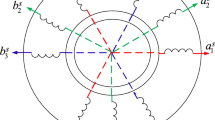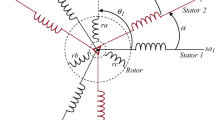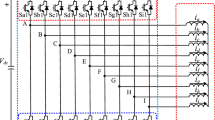Abstract
The aim of the present paper is to show the impact of the feed of multiphase induction machines by a voltage inverter which produces circulating harmonic currents. To eliminate this extra harmonic currents of stator windings that cause losses, a space vector PWM control strategy is employed and developed, based on the vector space decomposition for double-star induction machine modeling, while taking into account the stator mutual leakage between two stars. The simulation results illustrate the validity and efficiency of the proposed model.










Similar content being viewed by others
Abbreviations
- \({[}{R_\mathrm{s}}{]}\) :
-
Stator resistance matrix
- \({[}{R_\mathrm{r}}{]}\) :
-
Rotor resistance matrix
- \({[} {]}_{6}\) :
-
Identity matrix of 6 order
- \({[} {]}_{3}\) :
-
Identity matrix of 3 order
- \({l}_{\mathrm{s}}\) :
-
Stator leakage inductance
- \({L}_{\mathrm{ms}}\) :
-
Magnetization self-inductance stator
- \({l}_{\mathrm{mss}}\) :
-
Stator mutual leakage inductance between the two stars
- \({L}_{\mathrm{sr}}\) :
-
Mutual inductance between stator/rotor
- \({L}_{\mathrm{mr}}\) :
-
Magnetizing rotor inductance
- \({l}_{\mathrm{r}}\) :
-
Rotor leakage inductance
- p :
-
Number of pole pairs
- \('\) :
-
Transpose matrix value
- \({T}_{\mathrm{l}}\) :
-
Load torque
- \({T}_{\mathrm{em}}\) :
-
Electromagnetic torque
- J :
-
Inertia coefficient
- \(\omega _{\mathrm{m}}\) :
-
Rotor angular speed
- \(\lambda _{\mathrm{r}}\) :
-
Rotor flux linkage
- k :
-
Constant value \(1/\sqrt{3}\)
References
Farag K, Abo-Elyousr1, Rim GH (2010) Performance evaluation of AC/DC PWM converter for 12-phase stand-alone PMSG with maximum power extraction. In: International conference on electrical machines and systems (ICEMS), Incheon, pp 82–87
Apsley JM, Williamson S, Smith AC, Barnes M (2006) Induction motor performance as a function of phase number. In: Proceedings of the IEE electric power applications, vol 153, pp 1350–2352
Parsa L (2005) On advantages of multi-phase machines. In: 31st annual conference of IEEE Industrial Electronics Society, IECON, pp 1574–1579
Baltatanu AML (2013) Multiphase machines used in electric vehicles propulsion. In: International conference on electronics, computers and artificial intelligence (ECAI), pp 1–6
Tessarolo A (2010) Benefits of increasing the number of stator phases in terms of winding construction technology in highpower electric machines. In: 5th IET international conference on power electronics, machines and drives (PEMD), pp 1–6
Marouani K, Nounou K, Tabbache MB (2014) Power factor correction of an electrical drive system based on multiphase machines. In: International conference on green energy, pp 152–157
Baudart F, Dehez B, Matagne E et al (2012) Torque control strategy of polyphase permanent-magnet synchronous machines with minimal controller reconfiguration under open-circuit fault of one phase. IEEE Trans Ind Electron 60:2632–2644
Williamson S, Smith S (2004) Fault tolerance in multiphase propulsion motors. J Mar Eng Technol 4:3–7
Amimeur H, Aouzellag D, Abdessemed R, Ghedamsi K (2012) Sliding mode control of a dual-stator induction generator for wind energy conversion systems. Int J Electr Power Energy Syst 1:60–70
Che HS, Hew WP, Rahim NA et al (2012) A six-phase wind energy induction generator system with series-connected DClinks. In: IEEE power electronics for distributed generation systems conference, Aalborg, pp 26–33
Yashan Hu, Zi Zhu, Liu K (2014) Current control for dual three-phase permanent magnet synchronous motors accounting for current unbalance and harmonics. IEEE J Emerg Sel Topics Power Electron 2:272–284
Yazdani D, Khajehoddin SA, Bakhshai A, Joos G (2009) Full utilization of the inverter in split-phase drives by means of a dual three-phase space vector classification algorithm. IEEE Trans Ind Electron 56:120–129
Gopakumar K, Ranganathan VT, Bhat SR (1991) Split phase induction motor operation from PWM voltage source inverter. IEEE Ind Appl Soc Annu Meet Conf Rec 1:437–442
Marouani K, Khoucha F, Baghli L et al (2007) Study and harmonic analysis of SVPWM techniques for VSI-fed double star induction motor drive. In: Mediterranean conference on control and automation, pp 1 – 6
Zhao Y, Lipo TA (1995) Space vector PWM control of dual three phase induction machine using vector space decomposition. IEEE Trans Ind Appl 31:1100–1109
Jen-Ren Fu, Lipo Thomas A (2002) Disturbance free operation of a multiphase current regulated motor drive with an opened phase. IEEE Trans Ind Appl 30:1267–1274
Kamari M, Keramatzadeh M, Kianinezhad R (2009) Space vector double frame field oriented control of six phase induction motor. WSEAS Trans Syst Control 4:129–139
Hadiouche D, Baghli L, Rezzoug A (2006) Space vector PWM techniques for dual three-phase AC machines: analysis, performance evaluation and DSP implementation. IEEE Ind Appl Conf 42:1112–1122
Hadiouche D, Razik H, Rezzoug A (2000) Study and simulation of space vector PWM control of double star induction motors. In: IEEE international power electronics congress, pp 42–47
Saeedifard M, Bakhshai A R, Joos G et al (2003) Modified low switching frequency space vector modulators for high power multimodule converters. In: 18th annual IEEE applied power electronics conference and exposition, pp 555–556
Hadiouche D (2001) Contribution to the study of dual stator induction machines: modelling, supplying and structure. Ph. D. dissertation, University Henri Poincaré-Nancy I
Author information
Authors and Affiliations
Corresponding author
Rights and permissions
About this article
Cite this article
Kouki, H., Ben Fredj, M. & Rehaoulia, H. Harmonic analysis of SVPWM control strategy on VSI-fed double-star induction machine performances. Electr Eng 98, 133–143 (2016). https://doi.org/10.1007/s00202-015-0358-x
Received:
Accepted:
Published:
Issue Date:
DOI: https://doi.org/10.1007/s00202-015-0358-x




